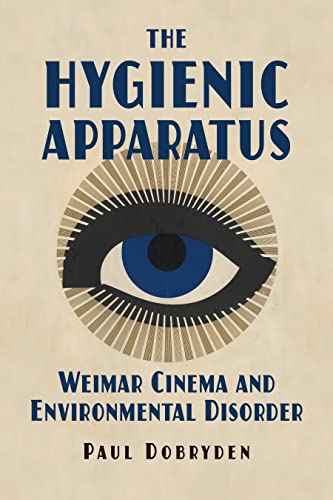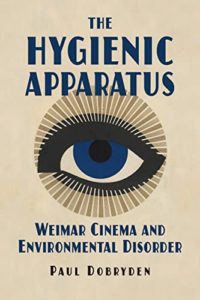

Paul Dobryden’s compelling study examines the way that “hygiene” became an organizing principle in Weimar society and culture, and argues that it shaped the development of cinema in the era, impacting not just content and aesthetics, but also manner of production and exhibition. Dobryden defines hygiene as those discourses and approaches that aimed to control the environment so as to optimize the health of the individual and the population as a whole. In post-WWI Germany, this project became particularly urgent: the extensive impact of the war on the environment and on the population, coupled with continuing industrialization and urbanization, made it imperative to construct programs that would shape the population according to society’s needs. That is, capitalist production required a healthy population of workers; hygiene, by controlling the environment to improve the population’s health, promised to guarantee that work force. The concept of hygiene, then, became pervasive: it shaped public and private space, health programs, political discourses, and cultural output. In other words, it became a part, as Dobryden argues, of Weimar Germany’s focus on “rationalization,” and on the attempt to draw on scientific knowledge and methods in approaching “three main areas of modern social life: industrial production, architecture and urban planning, and lifestyle” (13).
Cinema, Dobryden maintains, is a field in which we can see the impact of hygiene particularly clearly. For one, cinema began to develop in precisely those years in which hygiene as a construct became especially significant; thus, the material components of cinema—the spaces in which it was produced and shown, as well as technical components such as projection—came into being underpinned by the notion of hygiene. Further, its role as cultural force, entertainment, or means of education as well as indoctrination evolved in this environment that was dominated by the construct of hygiene. Hygiene, then, left its mark not only on cinema as an institution, but also on the content of cinema. Dobryden invites us to consider the centrality of the term and thus to reconsider some of the key cinematic texts of the era by examining the evolution of the idea of hygiene, as well as its different components and approaches, which he puts in dialogue with representative films.
Tracing the significance of hygiene as an organizing principle opens up a different lens onto the film industry of Weimar Germany. Hygiene, after all, is something that we might see primarily as a social, medical, and political project; to examine its reciprocal impacts on the cultural institution of cinema pushes us to take a new vantage point on both hygiene as organizing principle and cinema. Dobryden’s study intervenes to make visible and coherent these intertwined developments. For example, he discusses the points of connection between the Kinoreform movement, which saw cinema as a danger to physical health and psyche, and the focus on hygiene: both attempted to manage the spatial sites of cinema to minimize potential dangers to the spectator. Advocates of Kinoreform saw cinema as a force that could lead to moral decline, both through its content and the way it was viewed, with spectators—often women and children—sitting among strangers in a darkened space. For such reformers, it was thus not only that which was being watched, but also how it was being watched, that posed a danger. Hygienic concerns, too, were focused on the spatial, spurring the design of movie theaters that would minimize potential contamination. Moreover, hygiene affected not only the material circumstances of exhibition, but also the position that cinema came to occupy; indeed, hygienic concerns and the need to guard against the physical dangers to both the projectionists and other cinematic workers and spectators led to the regulation of cinema spaces as sites of industry. The fact that hygienic principles and safety measures developed for industrial spaces were applied to cinema certainly shaped its position, situating it as an industry.
Dobryden’s study moves beyond the structural effects of hygiene on cinema, however, by bringing the concept into direct dialogue with specific films. In some cases, this process gives insight into films that are likely unfamiliar to the reader. For example, he analyzes a range of Kulturfilme, educational films that focused on everything from health and disease to urban planning and architecture. Dobryden presents close readings of examples focused on individual homes, traffic, urban planning, and housing for the elderly and the disabled. In so doing, he not only introduces lesser-known films to the reader, but also convincingly traces how hygiene dominated such disparate areas of life. His readings of two films focused on the home demonstrate how domestic space became representative of a broader program of rationalization: if these spaces could be properly managed, the result would be a familial unit that is healthier, but also more efficient and productive. This emphasis on creating spaces which function as efficiently as possible is equally evident in the films treating traffic in the city, urban planning, and housing. In reading these films, Dobryden notes how hygiene and order were applied not only to the environment but also to individuals who might function “as sources of environmental disorder” (69). In other words, there are potential “bodies out of place” (103) that should be managed in such a way as to minimize the “disruption” they might cause. These readings offer new insight into how pervasive hygienic concerns became in the era, shaping policy in virtually all areas of life. Indeed, what is in these films presented in terms of safety and hygiene—the need for spaces in which old people and those with disabilities can function safely—reveals some of the points of contact between discourses of hygiene and eugenics and points towards the ways in which such an emphasis can and will ultimately be misused.
In addition to reading these lesser-known educational films, Dobryden re-reads certain canonical films through the lens of hygiene. His reading of F. W. Murnau’s Faust (1926) reveals the centrality of elements counter to hygienic ideals: dust, smoke, and fog dominate key scenes of the film. Dobryden reads this in connection with key themes of Faust, but also as a commentary on the film industry as a whole, where this preponderance of pollution was generally avoided. In other words, Murnau’s Faust, like his other films, breaks from the pattern in which “dominant film production practices and an aesthetic preference for ‘clean’ and ‘clear’ images reproduced a hygienic vision of the body, its environment, and the proper relationship between the two” (101). Dobryden sees similarly transgressive potential in other films, such as Karl Grune’s The Street (1923) and Murnau’s The Last Laugh (1924). Both of these films center on bodies that disrupt the smooth functioning of their environments. In The Street, any form of “disability” becomes dangerous: the blind grandfather, the child, and the drunken husband at the center of the narrative suggest that the urban milieu “functions as a potentially disabling environment” to the subject, whose “bourgeois masculinity is bound up with a normative conception of bodily ability” (117). In The Last Laugh, the protagonist’s age and growing weakness mark him as disabled; as such, he poses a danger to those around him, revealing just how vulnerable they, too, are. And yet, Dobryden argues, these films not only reveal these social structures of exclusion, but also question them, suggesting that there are alternatives and figuring cinema itself as a site which might challenge exclusion. This sort of challenge is one he sees attempted even more directly in short films focused on workers’ lives and in films like Kuhle Wampe (Dudow, 1932), which draw on and yet subvert some of the structures and approaches of the Kulturfilm. These films make explicit how problematic the construct of hygiene could be: it focused on efficiency but ignored structures of inequality that were ultimately at the root of those problematic areas it professed to mitigate.
Dobryden’s study is fascinating: it is wide-ranging, meticulously researched, and convincingly argued. Weimar cultural production seems to circulate around certain key concerns, anxieties, and hopes. The Hygienic Apparatus suggests that hygiene should be one of those areas and thus pushes us to shift and augment our understanding of Weimar culture. It is not only compelling to read, but also inspiring: I find myself wanting to follow Dobryden’s argument further, to consider, for example, how hygienic discourses might be implicated more broadly in constructions of gender, or how other canonical films of the era intersect with the concept. This is a study that should be of interest to scholars not only of Weimar film, but of film more broadly, as well as to those focusing on European modernity. It is not only an important addition to the scholarly work on Weimar cinema, but also an example of how fruitful an interdisciplinary approach to the field can be.
Anjeana K. Hans is Associate Professor of German Studies and Affiliated Faculty in Cinema and Media Studies at Wellesley College. She has published books and articles on gender, on representations of the other in Weimar cinema, and on independent Austrian films from the 1930s. Her recent book, Warning Shadows (2021), traces the disparate discourses that underpin the classic Weimar film of that title.
The Hygienic Apparatus: Weimar Cinema and Environmental Disorder
By Paul Dobryden
Publisher: Northwestern University Press
Hardcover and Paperback / 208 pages / 2022
ISBN: 9780810144972
Published on February 21, 2023.




